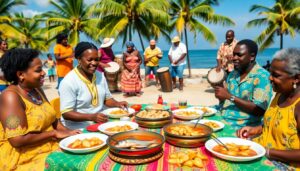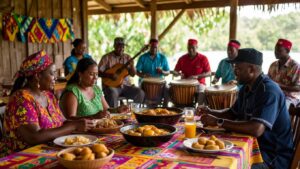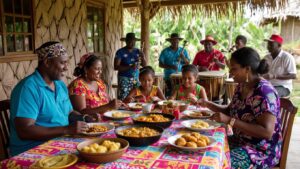Unveiling the Vibrant Garifuna Culture of Belize: Heritage, Culinary Wonders, and Immersive Experiences
The Garifuna people of Belize embody a dynamic blend of African, Indigenous Caribbean, and European influences, resulting in a distinctive cultural heritage that has gained international recognition, including a UNESCO designation. Their rich traditions span various facets such as language, music, culinary arts, dance, spirituality, and an unwavering sense of community. This comprehensive guide embarks on an exploration of the fascinating story of the Garifuna in Belize, examining their history, traditions, festivals, cuisine, and the lively cultural core of Hopkins Village.
Deepening Understanding of the Garifuna Heritage
The Garifuna represent one of the most prominent cultural groups in Belize, with roots tracing back to West and Central African ancestors alongside the Indigenous Caribs and Arawaks. After resisting colonial oppression in St. Vincent in 1797, they were forced into exile in Central America. Currently, the Garifuna population in Belize stands at around 30,000, significantly enhancing the cultural landscape of southern Belize through their unique language, delectable cuisine, vibrant art, and enduring customs. Their designation by UNESCO as a Masterpiece of the Oral and Intangible Heritage of Humanity underscores their continuing spirit, creativity, and adaptability, particularly in communities like Dangriga, Hopkins, Seine Bight, and Punta Gorda, as well as in diaspora communities across the Americas. Each year, the observance of Garifuna Settlement Day on November 19 highlights their narrative of resilience, community spirit, and rich cultural legacy.

Investigating the Historical Roots of the Garifuna People
Tracing the Rich Ancestry of African and Carib Heritage
The story of the Garifuna people commences in the 17th century with the extraordinary convergence of African survivors from two Spanish slave ships and the Indigenous Carib and Arawak inhabitants of St. Vincent in the Lesser Antilles. Over 150 years, intermarriage and cultural exchange fostered a unique Afro-Indigenous identity known as the Garinagu. This identity is characterised by a rich tapestry of traditions, languages, and practices that reflect their diverse ancestral lineages and cultural influences.
Overcoming Forced Exile and Creating New Beginnings in Belize
In 1797, after fierce resistance against British colonial forces, approximately 5,000 Garifuna were forcibly exiled from St. Vincent to Roatán, Honduras. This marked the onset of migrations that spread along the Central American coastline. By the early 19th century, flourishing Garifuna communities had emerged in southern Belize, particularly in culturally vibrant regions such as Dangriga, often referred to as the cultural capital, as well as Hopkins, Seine Bight, and Barranco. The British authorities backed these migrations, seeking skilled labourers adept in fishing and agriculture, thereby facilitating the growth of these communities.
Cultural Resilience and Continuity Amidst Adversity
Despite the numerous challenges posed by European colonisation, land dispossession, and systemic discrimination, the Garifuna have successfully safeguarded their language, social institutions, and profound religious traditions. The establishment of the National Garifuna Council in 1981 has been instrumental in advocating for cultural rights and education, ensuring that the Garifuna heritage is continually celebrated and recognised.
The Importance of Language and Identity in Garifuna Culture
Distinctive Features of the Garifuna Language
The Garifuna language is an Arawakan language notable for its incorporation of Carib and African loanwords, making it an extraordinary example within Central American languages. It features gendered pronouns, a complex tense system, and a rich array of oral traditions reflecting the community's history and cultural values. However, the survival of the Garifuna language is currently under threat due to a language shift caused by migration and urbanisation, with less than 15,000 Belizean Garifuna individuals remaining fully fluent.
Initiatives for Revitalisation and Preservation of the Language
The recognition of the Garifuna language and music as Intangible Heritage by UNESCO in 2001 has sparked revitalisation efforts across various communities. In areas like Hopkins and Dangriga, primary schools now offer educational programmes in Garifuna, while community radio stations broadcast music and news in the language, contributing to its preservation. Organisations such as GAMAE International have implemented language immersion summer camps aimed at reconnecting youth with their ancestral roots and linguistic heritage.
Expressions of Identity and Connections within the Global Diaspora
The Garifuna identity is reinforced through traditional attire, ancestral lineage, clan totems, and distinctive naming customs. This identity is actively nurtured by cultural associations both within Belize and in diaspora communities located in major urban centres such as New York, Los Angeles, and London, where they continue to celebrate and uphold their rich heritage.
The Energetic Realm of Garifuna Music and Dance
Rhythmic Drumming and Its Spiritual Significance
Garifuna music is distinguished by its intricate rhythmic patterns, which seamlessly blend traditional African polyrhythms with indigenous chants. Central to many spiritual rituals and celebratory events, the drums—specifically the primero (tenor) and segunda (bass)—play a crucial role. The sacred dugú ceremony, for example, features drum circles and ancestral invocations that aim to heal or bless families, illustrating the profound connection between music and spirituality within Garifuna culture.
The Dynamic Dance Styles of Punta and Punta Rock
Among the most celebrated Garifuna dance forms is the punta, characterised by rapid hip movements and intricate footwork, often accompanied by call-and-response singing and vibrant percussion. The contemporary evolution of this dance style, known as punta rock, has been popularised by renowned musicians such as Andy Palacio and Pen Cayetano, who creatively blend traditional rhythms with modern instrumentation, thereby helping to spread the essence of Garifuna culture to audiences worldwide.
Culture Festivals and Community Celebrations: A Living Heritage
In the lively towns of Hopkins and Dangriga, dance troupes frequently perform during cultural festivals and for visiting tourists, forging a living connection between generations. These performances not only celebrate Garifuna heritage but also serve as an essential economic resource for the community, fostering tourism and cultural exchange that enriches both locals and visitors alike.

Unpacking Garifuna Cultural Practices and Spiritual Beliefs
The Importance of the Dugú Ceremony
The dugú ceremony is a significant multi-day event where extended families gather to pay homage to the spirits of their ancestors, known as gubida. Led by a spiritual healer, or buyei, the ceremony encompasses music, dance, and communal feasting, all aimed at restoring harmony within families and the broader community. It highlights a deep respect for the land, ancestral heritage, and the collective responsibilities that unite them.
Daily Life and Spiritual Beliefs of the Garifuna Community
The spiritual beliefs of the Garifuna represent a unique fusion of Catholicism and African as well as Arawak cosmologies. Everyday life is punctuated by various rituals, which include blessings for new buildings, rites of passage for births and deaths, and agricultural celebrations. Important symbols, such as the conch shell, sea turtle, and cassava, serve as vital connections between households, the natural world, and ancestral spirits.
Delving into the Flavours of Garifuna Cuisine and Gastronomy
Exploring Culinary Staples and Signature Dishes
The culinary landscape of Garifuna culture is deeply rooted in staples such as cassava (or yuca), plantains, coconut, and fresh seafood. Among traditional offerings, ereba stands out as a unique cassava bread crafted from grated cassava that is pressed and toasted over an open flame. Another signature dish, hudut, features fish cooked in rich coconut milk and is served alongside mashed green and ripe plantains. Machuca, a hearty fish soup with garlicky, mashed plantain dumplings, and tapou, a savoury seafood stew in coconut milk, are also favourites. In bustling street markets in Hopkins and Dangriga, visitors can indulge in local delights such as cassava pone (a sweet cake), fried plantain balls (known as ganún), and refreshing conch ceviche.
Commitment to Sustainable Food Practices
Traditional Garifuna practices, such as seasonal fishing, shellfish gathering, and small-scale gardening, promote a strong sense of ecological stewardship. These practices are guided by cultural taboos and communal resource management principles that ensure sustainability. Culinary festivals held in Hopkins showcase engaging cooking contests and food tours facilitated by women’s cooperatives, ensuring the preservation of cherished recipes and culinary techniques while inviting visitors to experience the rich gastronomic heritage of the Garifuna.
Hopkins Village: The Heart of Garifuna Culture
Historical Context and Cultural Significance
Founded in the early 1800s and known as Yarumein in Garifuna, Hopkins is nestled along the stunning Stann Creek coast. It serves as a vital hub for the Garifuna language, music, and arts and crafts, embodying the rich cultural legacy of the community throughout the years.
Essential Experiences to Encounter in Hopkins
- Drum Circles: Join daily drum schools and enjoy vibrant nightly drum circles at local cultural centres.
- Garifuna Museum: Discover fascinating artifacts, oral histories, and photographic archives that delve into the migration, language, and music of the Garifuna.
- Homestays and Workshops: Engage with local families who offer authentic cooking lessons, fishing excursions, and demonstrations of traditional cassava bread making.
Annual cultural events in Hopkins, especially the youth pageants during Garifuna Settlement Day, position the village as an authentic gateway to experiencing the rich cultural tapestry of Garifuna Belize.
Economic Impact of Cultural Tourism in Hopkins
Cultural tourism significantly contributes to the economy of Hopkins, supporting over 75% of local households through guest accommodations, handicrafts, music classes, and guided tours. The headquarters of the National Garifuna Council plays a pivotal role in coordinating regional festivals and advocacy initiatives, ensuring that Garifuna culture remains vibrant and visible to the broader world.
Commemorating Garifuna Settlement Day: A Celebration of Culture
Understanding the Historical Importance of Settlement Day
Celebrated annually on November 19 since 1941 and nationally recognised since 1977, Garifuna Settlement Day commemorates the significant arrival of Garifuna ancestors in Belize via canoe in 1802. The reenactment procession known as Yurumein brings villagers ashore carrying drums, cassava, and crops amidst joyful singing and prayer, symbolising their enduring legacy and connection to their homeland.
Modern Celebrations and Festivities of Settlement Day
The festivities of Garifuna Settlement Day beautifully intertwine sacred and secular elements, featuring all-night dugú ceremonies and all-day drumming in churches and community squares. Processions adorned in traditional regalia, lively parades, dance performances, and food fairs mark the day. National broadcasts, media features, and diaspora celebrations in major US cities attract visitors from across Belize and beyond, augmenting awareness and appreciation of Garifuna cultural traditions.
Addressing Contemporary Challenges and Sustaining Cultural Heritage
Confronting Language Shift Among Younger Generations
The language shift poses a significant threat to the Garifuna community, as many young individuals, particularly in urban areas, increasingly communicate in English or Kriol at home. UNESCO has recognised this concerning trend, prompting schools and NGOs to implement language immersion programmes, radio broadcasts, and mentorship initiatives aimed at preserving linguistic heritage and cultural identity among the youth.
Navigating Land Rights and Tourism Development Issues
The rapid growth of tourism and real estate development in coastal regions like Seine Bight and Hopkins jeopardises traditional landholdings of the Garifuna. Advocacy from the National Garifuna Council and collaborative NGOs focuses on securing land rights, influencing urban planning, and ensuring that tourism revenues benefit local families and communities, thereby fostering sustainable development.
Engaging Youth through Arts, Technology, and Diaspora Connections
Garifuna artists and musicians, both locally and in the diaspora, are actively recording music, documenting recipes, and preserving oral histories to create digital archives and virtual festivals. These modern platforms are vital in nurturing connections between the broader Garifuna community and younger generations, ensuring that the rich cultural heritage is maintained and celebrated for years to come.
Guidelines for Experiencing Garifuna Culture Responsibly
- Opt for accommodations in Hopkins, Dangriga, or Seine Bight, and book tours directly with Garifuna-owned businesses to support the local economy and community.
- Participate in a drum workshop, attend a Settlement Day celebration, or volunteer in local cultural preservation initiatives to immerse yourself in Garifuna culture.
- Support women’s cooperatives by sampling traditional dishes or purchasing handcrafted items to promote sustainable livelihoods within the community.
- Always show respect for local customs; seek permission before taking photographs of individuals, and be mindful during rituals and ceremonies.
- Learn a few basic phrases in the Garifuna language to demonstrate your respect and genuine curiosity for the culture and its people.
The Garifuna culture in Belize represents a vibrant tapestry woven from resilience, profound spirituality, infectious music, delectable culinary delights, and robust community ties. By visiting places like Hopkins or Dangriga, participating in local festivals, or immersing oneself in the rhythmic heartbeat of the drums, travellers are presented with a unique opportunity to connect with a rich historical continuum where the past and present coalesce. Supporting Garifuna-owned businesses, honouring their traditions, and celebrating the linguistic and culinary diversity of this remarkable culture are vital steps towards ensuring its survival and flourishing for future generations.
References and Further Reading on Garifuna Culture
- Language, Dance and Music of the Garifuna – UNESCO Intangible Heritage
- History Of The Garifuna People – Belize.com
- Garifuna people – Wikipedia
- Varner, G.R. “Native Status and Maya Identity in Belize.” Journal of Latin American Anthropology, 1998
- Lee, N.R. “Toledo Garifuna and Indigenous Rights.” Mesoamerican Research, 2022
- National Garifuna Council – Wikipedia
- The Garifuna Living Heritage – ICH NGO Forum, 2023
- Dinther, R. “Language Shift and Prestige: Garifuna in Hopkins.” Journal of Pidgin and Creole Languages, 2017
- Habinaha Garifuna Language Program
- Veal, T. “Africanisms in Garifuna Culture of Belize.” Cultural Anthropology, 2004
- National Geographic: Preserving Garifuna Identity Through Ritual
- Music In Africa: Punta Rock and Garifuna Music
- Hopkins Cultural Center Official Site
- Cultural Survival Quarterly: Maya Rainforest and Garifuna in Belize
- Belize Living Heritage: Rituals and Social Practices
- Texas A&M: Belizean Food Culture
- Love Your Belize: Hudut Recipe
- Global M&A Pages: Sustainable Fishing Cooperatives
- National Garifuna Council of Belize
- UN Sustainable Development Reports on Garifuna Cultural Tourism
- Ambergris Caye: Garifuna Settlement Day Celebrations
- Garifuna.com: Diaspora, Digital Storytelling, and Modern Initiatives
The article Garifuna Culture in Belize: Heritage, Food & Where to Experience It first appeared on Belize Travel Guide
The article Garifuna Culture: Experience Heritage and Cuisine in Belize was found on https://limitsofstrategy.com


